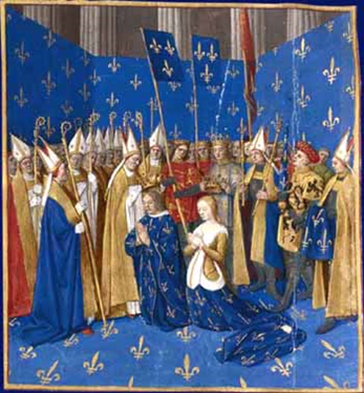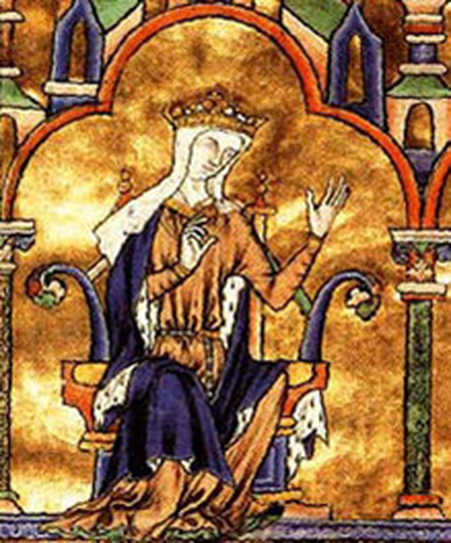 The Coronation of Louis VIII and Blanche of Castile at Reims
The Coronation of Louis VIII and Blanche of Castile at Reimsin 1223, ca. 1455–60 CE, Jean Fouquet (1274–1518 CE) Paris,
Les Grandes chroniques de France
© Bibliothèque Nationale de France.
Blanche of Castile, 1188-1252
Ancestral Roots Line 113:28
Daughter to Alfonso VIII of Castile, consort of Louis VIII, granddaughter of Eleanor of Aquitaine who at 80 arranged for Blanche’s marriage to Louis, traveling from England to Spain to escort Blanche to France, a gesture designed to emphasize the importance of a union for peace between Spain and England. Encouraged by English barons after John of England’s death in 1216 Louis invaded England to boldly seize the English throne in Blanche’s name but with the 1217 loyalist victory at the Battle of Lincoln under Nicholaa de la Haye he realized his support had eroded in favor of John’s nine year old son who was crowned Henry III under the regency of William Marshal.
Louis VIII succeeded to the throne of France in 1223 but died three years later. His deathbed testament explicitly left the administration of the kingdom in Blanche’s hands as feudal law had none of the restrictions of Roman law and women could inherit fiefs on a par with men. As regent of France and guardian of their children Blanche immediately held the knighting and coronation of her twelve year old son Louis IX. Within weeks of the coronation Blanche rode into battle at the head of her own troops with a surprise attack mid January to quell rebellious nobles, when the nobles tried to abduct her son she expelled them replacing them with commoners. In 1229, she was responsible for the Treaty of Paris which ushered in an era of peace. Blanche was finically astute, able to maintain support of the people by never over imposing taxes and knowing how to make the court live within it means yet also realizing when it was politically important to spend liberally. She was acutely aware of negotiations throughout the region maintaining a spy system that would rival anything of today. After Louis reached majority in 1235, Blanche continued to be a large influence both in his life and affairs of state and assumed regency again in 1248 when he embarked on the Seventh Crusade.
Ancestral Roots Line 113:28
Daughter to Alfonso VIII of Castile, consort of Louis VIII, granddaughter of Eleanor of Aquitaine who at 80 arranged for Blanche’s marriage to Louis, traveling from England to Spain to escort Blanche to France, a gesture designed to emphasize the importance of a union for peace between Spain and England. Encouraged by English barons after John of England’s death in 1216 Louis invaded England to boldly seize the English throne in Blanche’s name but with the 1217 loyalist victory at the Battle of Lincoln under Nicholaa de la Haye he realized his support had eroded in favor of John’s nine year old son who was crowned Henry III under the regency of William Marshal.
Louis VIII succeeded to the throne of France in 1223 but died three years later. His deathbed testament explicitly left the administration of the kingdom in Blanche’s hands as feudal law had none of the restrictions of Roman law and women could inherit fiefs on a par with men. As regent of France and guardian of their children Blanche immediately held the knighting and coronation of her twelve year old son Louis IX. Within weeks of the coronation Blanche rode into battle at the head of her own troops with a surprise attack mid January to quell rebellious nobles, when the nobles tried to abduct her son she expelled them replacing them with commoners. In 1229, she was responsible for the Treaty of Paris which ushered in an era of peace. Blanche was finically astute, able to maintain support of the people by never over imposing taxes and knowing how to make the court live within it means yet also realizing when it was politically important to spend liberally. She was acutely aware of negotiations throughout the region maintaining a spy system that would rival anything of today. After Louis reached majority in 1235, Blanche continued to be a large influence both in his life and affairs of state and assumed regency again in 1248 when he embarked on the Seventh Crusade.
|
Blanche proved to be a strong and able ruler, “a man’s valour within a woman’s heart” securing her position by eliciting oaths of allegiance, handing out rewards, leading armies, raising and building castles and making treaties. Deeply devout she taught her children to be profoundly pious with Louis and her daughter Isabella both canonized. Blanche was an important patron of the Cistercian Order, founding two female abbeys and endowed the north transept window of Notre-Dame de Chartes which is surround by symbols of biblical, French and Castilian power, celebrating a major theme of Blanche’s life, the power of a royal mother and her son.
|

Read her letters: https://epistolae.ctl.columbia.edu/woman/77.html
References and Further Reading
References and Further Reading
- “Blanche regina.” Foundations for Medieval Genealogy. FRANCE, CAPITIAN KINGS, C. KINGS OF FRANCE 987—1328, LOUIS de France. Web. 22 May 2016. //fmg.ac/Projects/MedLands/CAPET.htm.
- Jackson-Laufer, Guida M. Women Who Ruled: A Biographical Encyclopedia. Barnes & Noble Books, 1998
- Koman, Alan J. A Who’s Who of Your Ancestral Saints. Genealogical Publishing Co., 2010.
- Labarge, Margaret Wade. A Small Sound of the Trumpet, Women in Medieval Life. Beacon Press, 1986.
- Medieval Women’s Latin Letters. https://epistolae.ctl.columbia.edu/women.
- Pernoud, Regine. Blanche of Castile. Translated by Henry Noel. Coward, McCann & Geoghegan, Publishing, 1975.
